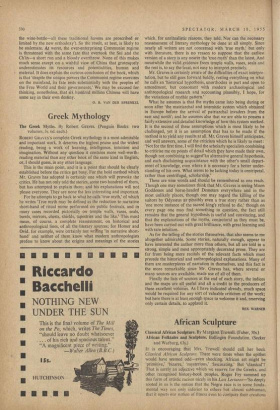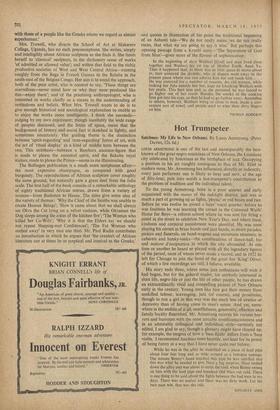with those of a people like the Greeks whom we
regard as almost superhuman.'
Mrs. Trowel!, who directs the School of Art at Makerere College, Uganda, has no such preconceptions. She writes, simply and intelligibly about African sculpture as she finds it. She limits herself to 'classical' sculpture, in the dictionary sense of works 'of admitted or allowed value'; and within that field to the richly productive societies of West and West Central Africa—running roughly from the Baga in French Guinea to the Baluba in the south-cast of the Belgian Congo. Her aim is to avoid the approach, both of the pure artist, who is content to say, 'These things arc marvellous—never mind how or why they were produced like this—enjoy them'; and of the practising anthropologist, who is interested in works chiefly as a means to the understanding of institutions and beliefs. What Mrs. Trowell wants to do is to give enough historical and sociological explanation to enable us to enjoy the works more intelligently. I think she succeeds— judging by my own enjoyment; though inevitably the wide range of peoples discussed, and the limits of space, mean that the background of history and social fact is sketched in lightly, and sometimes uncertainly. Her guiding theme is the distinction between 'spirit-regarding' and 'man-regarding' forms of art, with the art of 'ritual display' as a kind of middle term between the two. This antithesis—between a Bambara ancestor-figure that is made to please the ancestral spirit, and the Bakuba royal statues, made to please the Prince—seems to me illuminating.
The Bollingen publication is a much more sumptuous affair— the most expensive champagne, as compared with good burgundy. The reproductions of African sculpture cover roughly the same ground, but naturally gain a great deal from the folio scale. The first half of the book consists of a remarkable anthology of eighty traditional African stories, drawn from a variety of sources—from Bushmen to Hausa. The titles give some idea of the variety of themes: 'Why the Chief of the Smiths was unable to create Human Beings'; 'How it came about that we shall always sec Okra the Cat lying on a velvet cushion, while Okraman the Dog sleeps among the ashes of the kitchen fire'; 'The Woman who killed her Co-Wife'; 'Why it is that the Elders say we should not repeat Sleeping-mat Confidences'; 'The Fat Woman who melted away' (a very nice one this). Mr. Paul Radii.' contributes an introduction in which he argues that 'the creators of African literature can at tines be as sceptical and ironical as the Greeks,' and quotes in illustration of his point the traditional beginning of an Ashanti tale—'We do not really mean, we do not really mean, that what we are going to say is true.' But perhaps this opening passage from a Krachi story—'The Separation of God from Man'—gives more of the flavour of sophistication : In the beginning of days Wulbari [God] and man lived close together and Wulbari lay on top of Mother Earth, Asasi Ya. Thus it happened that, as there was so little space to move about in, man annoyed the divinity, who in disgust went away to the present place where one can admire him but not reach him. . . . He was annoyed for a number of reasons. An old woman, while making her tub/ outside her hut, kept on knocking Wulbari with her pestle. This hurt him and, as she persisted, he was forced to go higher out of her reach. Besides, the smoke of the cooking fires got into his eyes. so that he had to go farther away. According to others, however, Wulbari being so close to men, made a con- venient sort of towel, and people used to wipe their dirty fingers on him.
TI IOMAS HODGKIN











































 Previous page
Previous page